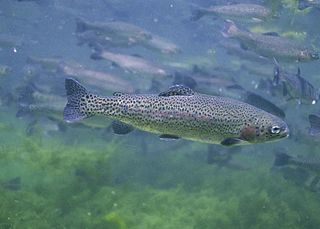
The rainbow trout is a species of trout native to cold-water tributaries of the Pacific Ocean in Asia and North America. The steelhead is an anadromous (sea-run) form of the coastal rainbow trout(O. m. irideus) or Columbia River redband trout (O. m. gairdneri) that usually returns to freshwater to spawn after living two to three years in the ocean. Freshwater forms that have been introduced into the Great Lakes and migrate into tributaries to spawn are also called steelhead.

The cutthroat trout(Oncorhynchus clarkii) is a fish species of the family Salmonidae native to cold-water tributaries of the Pacific Ocean, Rocky Mountains, and Great Basin in North America. As a member of the genus Oncorhynchus, it is one of the Pacific trout, a group that includes the widely distributed rainbow trout. Cutthroat trout are popular gamefish, especially among anglers who enjoy fly fishing. The common name "cutthroat" refers to the distinctive red coloration on the underside of the lower jaw. The specific name clarkii was given to honor explorer William Clark, coleader of the Lewis and Clark Expedition.

Field & Stream is an American online magazine focusing on hunting, fishing and other outdoor activities. The magazine was a print publication between 1895 and 2015 and became an online-only publication from 2020.

The Kentucky Department of Fish and Wildlife Resources, an agency of the Kentucky Tourism, Arts and Heritage Cabinet, is responsible for the conservation of wildlife resources and for boating projects in the state. A commissioner appointed by the Fish and Wildlife Commission heads the department. The commission—which oversees the department's commissioner and promulgates regulations governing fishing, hunting, and boating—is a nine-member bipartisan board appointed by the governor from a list of candidates nominated by active hunters and anglers in each of nine geographic districts in the state.

Boise National Forest is a National Forest covering 2,203,703 acres (8,918.07 km2) of the U.S. state of Idaho. Created on July 1, 1908, from part of Sawtooth National Forest, it is managed by the U.S. Forest Service as five units: the Cascade, Emmett, Idaho City, Lowman, and Mountain Home ranger districts.
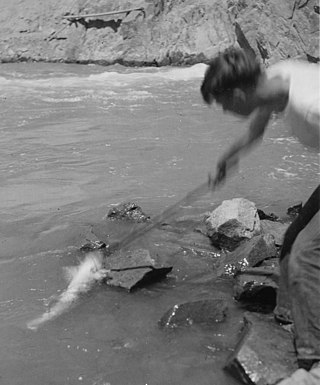
Snagging, also known as snag fishing, snatching, snatch fishing, jagging (Australia), or foul hooking, is a fishing technique for catching fish that uses sharp grappling hooks tethered to a fishing line to externally pierce into the flesh of nearby fish, without needing the fish to swallow any hook with its mouth like in angling. This is achieved by suddenly and vigorously pulling the line when movement is felt, causing the snag hook to "claw" into any fish unfortunate enough to be grappled by the hook points. Weighted multi-hook rigs can be used to increase chances of success, and modern technologies such as underwater video camera can also be used to visually aid and time the snagging.

Outdoor Life is an outdoors magazine about camping, fishing, hunting, and survival. It is a sister magazine of Field & Stream. Together with Sports Afield, they are considered the Big Three of American outdoor publishing by Money magazine. Outdoor Life was launched in Denver, Colorado, in January 1898. Founder and editor-in-chief (1898–1929), J. A. McGuire, intended Outdoor Life to be a magazine for sportsmen, written by sportsmen, covering all aspects of the outdoor arena.
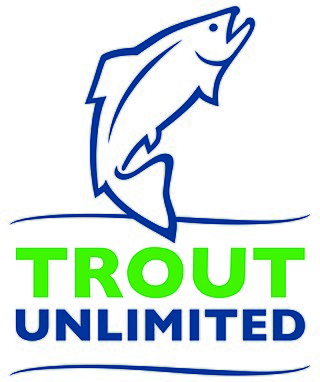
Trout Unlimited (TU) is a US non-profit organization dedicated to the conservation of freshwater streams, rivers, and associated upland habitats for trout, salmon, other aquatic species, and people. It is headquartered in Arlington, Virginia. The organization began in 1959 in Michigan. It has since spread throughout the United States and has local chapters in nearly every State in the United States.

Pheasants Forever, Inc. (PF), a 501(c)(3) non-profit conservation organization, is dedicated to conserving wildlife habitat suitable for pheasants. Formed in 1982 as a response to the continuing decline of upland wildlife and habitat throughout the United States, Pheasants Forever, and its quail conservation division, Quail Forever, have a combined membership of approximately 150,000 throughout North America.

Ralph W. "Bud" Leavitt Jr. was a Maine newspaperman who was executive sports editor of the Bangor Daily News, and a longtime outdoor columnist recognized statewide. In addition to his writing, Leavitt hosted one of Maine's earliest television shows, which was devoted to fishing, hunting and the out-of-doors. Leavitt's stature within the state was such that columnist Roy Blount Jr. wrote of the Maine sportswriter that he "fishes with Ted Williams and Red Smith – or, rather, they trout-fish with him." An early conservationist and son of a paper mill union leader, Leavitt urged the state of Maine to acquire lands for public use; one such preserve is today named for the sportswriter and television personality.
Outdoor Canada is Canada's national fishing and hunting magazine, in print since 1972 with a mix of how-to articles, buyer's guides, profiles, travelogues, reports, and analyses. In 2015, Outdoor Canada West was launched.
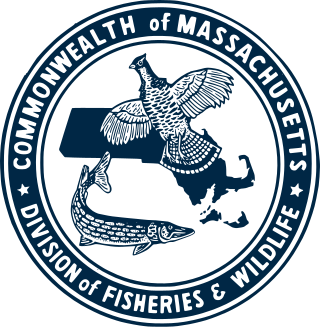
The Massachusetts Division of Fisheries and Wildlife, sometimes referred to as MassWildlife, is an agency of the Massachusetts Department of Fish and Game, within the Executive Office of Energy and Environmental Affairs. The Massachusetts Division of Fisheries and Wildlife (DFW) is responsible for the conservation - including restoration, protection and management - of fish and wildlife resources for the benefit and enjoyment of the public. MassWildlife was founded as a state fisheries commission in 1866 in response to citizen concerns about the loss of Atlantic salmon to dams and pollution. The agency's activities are mainly supported by revenue from the sale of hunting, trapping and fishing licenses, stamps and permits; returns from federal taxes on hunting and fishing equipment; various bond initiatives (primarily for land purchase. Additional funding is derived from voluntary donations from businesses, conservation organizations, and individuals.
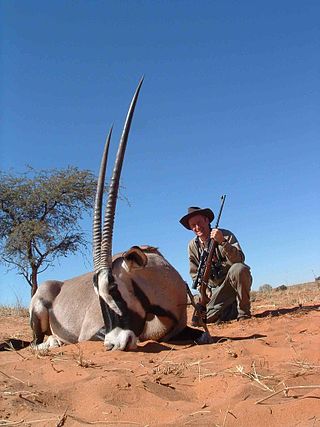
Gary Lewis is an outdoor writer, author and TV host residing in Bend, Oregon.
Lee Wulff, born Henry Leon Wulff, was an artist, pilot, fly fisherman, author, filmmaker, outfitter and conservationist who made significant contributions to recreational fishing, especially fly fishing and the conservation of Atlantic Salmon.
Hartt Partridge Wixom was an American writer who specialized in the topics of hunting, fishing, wildlife and environmental protection, and Latter-Day Saints (LDS) history. His most recent works focus on early LDS history: Jacob Hamblin (2008), Profiles in Mormon Courage (2007), and Critiquing the Critics of Joseph Smith (2005). Another book on early LDS history, Edward Partridge (1998), is a biography of Wixom's great-great-grandfather, the first presiding bishop of the LDS church. In 1998 Wixom gave the annual Juanita Brooks Lecture at Dixie State College in St. George, Utah on the subject of Jacob Hamblin. In 2009 Wixom was the featured speaker at the annual Jacob Hamblin Days celebration in Kanab, Utah.

Dr. Robert J. Behnke was an American fisheries biologist and conservationist who was recognized as a world authority on the classification of salmonid fishes. He was popularly known as "Dr. Trout" or "The Trout Doctor". His seminal work, Trout and Salmon of North America, was published in 2002. He wrote a regular column for Trout Magazine, the quarterly publication of Trout Unlimited. He was a fisheries biologist with the U.S. Fish and Wildlife Service in the Colorado Cooperative Fish and Wildlife Research Unit and a professor at Colorado State University in the 1970s. He became a Professor Emeritus at the Department of Fishery and Wildlife Biology at Colorado State University.
Joseph White Brooks was an American fly fisherman and popular writer about the sport of fly fishing during the mid-20th century. He was born in Baltimore, Maryland in 1901 and died in Rochester, Minnesota in 1972. He wrote for the leading fishing and outdoor magazines of the day and was the outdoor editor for The Baltimore Sun. He also wrote ten books about fly fishing, several of which are still considered leading authorities on the subject. He is listed by a leading online fly fishing publication, Fly Fishing Frenzy, as one of the 10 most influential fishermen ever. And the IGFA and others said he did more to popularize and expand fly fishing than any other individual.
Edward Geary Zern was a writer, humorist, fisherman, environmentalist and conservationist. Zern was a popular columnist at Field & Stream Magazine.
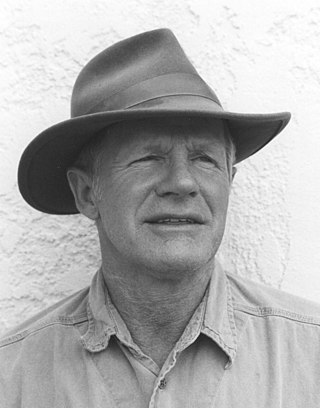
Maynard Hubbard "Dutch" Salmon II was an American outdoor writer, publisher, and founder of High-Lonesome Books, a publishing company in Silver City, New Mexico. He was a conservationist, environmental activist, fisherman, and homesteader based in New Mexico. Salmon was also a coursing sighthound breeder, trainer, and hunter.













